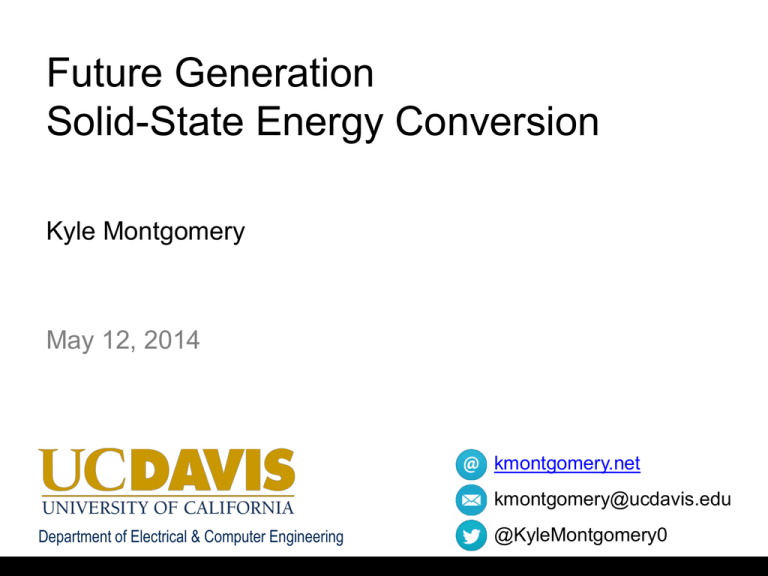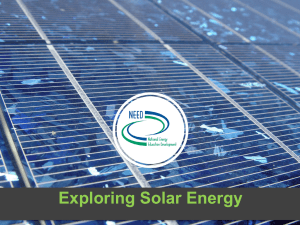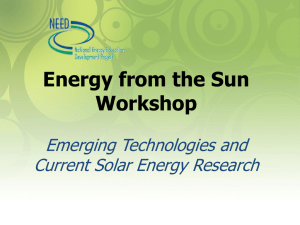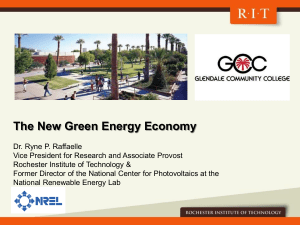kyle_montgomery_job-talk - web
advertisement

Future Generation Solid-State Energy Conversion Kyle Montgomery May 12, 2014 kmontgomery.net kmontgomery@ucdavis.edu Department of Electrical & Computer Engineering @KyleMontgomery0 1 About Me To 2000 In the beginning… 2004 Bachelor’s 2004-2007 Professional 2008 Master’s 2012 PhD Present Research & Lecturer Intern 2 Influences Jerry Woodall Distinguished Professor, UC Davis NAE Member, National Medal of Technology Compound Semiconductor Materials & Devices David Wilt Tech Lead, Air Force Research Lab, Space Vehicles Former Lead PV Engineer at NASA Space Photovoltaics, III-V MOVPE Mark Lundstrom Distinguished Professor, Purdue NAE Member Electron Transport and Device Modeling 3 Overview Motivation • The Energy Dilemma • Opportunities Research • Photovoltaics • Future Directions Teaching • Experience: Purdue & UC Davis • Future Directions 4 Overview Motivation • The Energy Dilemma • Opportunities Research • Photovoltaics • Future Directions Teaching • Experience: Purdue & UC Davis • Future Directions 5 The Energy Dilemma (1/2) 1. We use too much energy Total Global Energy Total Energy by Country OECD: Organization for Economic Cooperation and Development EIA, International Energy Outlook 2013 6 The Energy Dilemma (2/2) 2. We waste too much energy Mostly Waste Heat Coal (41%) Conversion Loss (62%) Natural Gas (25%) Nuclear (21%) Renewables (12%) Residential (12%) Commercial (12%) Industrial (9%) US EIA, Monthly Energy Review (January 2014) 7 Opportunity: Solar Resource Covering US ~20M TWh / yr 2011 US Electricity Consumption 4100 TWh Equiv. Land Area ~2000 km2 ½ the size of Rhode Island 8 Wide Bandgap Cells for Multijunctions Eg > 2 eV K. Montgomery, PhD Thesis, 2012 9 Opportunity: Lighting Efficiency 17% Percentage of total residential & commercial electricity used for lighting in US (EIA, 2011) Incandescent Halogen Compact Fluorescent Linear Fluorescent High Intensity Discharge (HID) Light Emitting Diode (LED) Efficacy [lm / W] US DoE, Solid-State Lighting Technology Fact Sheet, PNNL-SA-94206, March 2013. 10 Better Ways for Solid State Lighting Current Technology: Low Cost, Decent Quality Ideal Technology: High Cost, Superior Quality NEED: True Green LED 11 Overview Motivation • The Energy Dilemma • Opportunities Research • Photovoltaics • Future Directions Teaching • Experience: Purdue & UC Davis • Future Directions 12 Research Contributions • Reviving Liquid Phase Epitaxy • GaP Solar Cells – 2x improvement in spectral response • AlGaAs Solar Cells – Enhanced Luminescence Near Crossover – Towards Dual Junction Integration on Si • III-V / II-VI Digital Alloys • Integration to Novel Energy Conversion Systems 13 Semiconductor Menu 14 Liquid Phase Epitaxy – Rotating Chamber Benefits: • Perfected Crystal Structure • Better Stoichiometry • High Growth Rates • Economical Challenges: • Stable Growth Conditions • Low Supersaturation K. Montgomery, PhD Thesis, 2012 15 Current Density (mA/cm2) GaP Solar Cells Internal QE Voltage (V) C. R. Allen, et al., Sol. Energ. Mat. Sol. C., 94, 865 (2010). Wavelength (nm) 16 Gettering in GaP Liquid O- Solid Ga Al Mole Fraction P P AlGaP Al-Ga @ 975°C K. Montgomery, et. al., JEM, 40, 1457-1460 (2011). GaP Substrate 17 Gettering Yields Higher Response Zn-S Zn-O Exciton K. Montgomery, et. al., JEM, 40, 1457-1460 (2011). 18 AlGaAs Solar Cells by LPE X. Zhao et.al, PVSC 40 (2014), K. Montgomery, et. al., EMC (2012) 19 Non-Isovalent Alloys 20 ZnSe-GaAs Digital Alloy • Superlattice Miniband formation • Potential problem: intermediary compounds at interfaces Effective Band Gap S. Agarwal, K. H. Montgomery, et. al., Electrochemical and Solid-State Letters, 13, H5 (2010). 21 Wide Bandgap Cells for Hybrid PV-PT • Goal: Maximize solar energy conversion using PV + Heat • Benefit: Direct heat absorption allows for storage Temperature (°C) System Efficiency (@100x) K. Montgomery, et. al., PVSC 39 (2013) & Manuscript in Preparation PV Bandgap (eV) 22 Future Directions Wide Bandgap Solar Cells • Gettered Devices • Integrated Nanostructures • Tandem Integration Engineered Superstrates • Hybrid Epitaxy • III-V on Si • Polycrystalline III-V • ZnSe-GaAs Epitaxy • Growth & Doping • Heterojunction Devices Non-Isovalent Semiconductors 23 Overview Motivation • The Energy Dilemma • Opportunities Research • Photovoltaics • Future Directions Teaching • Experience: Purdue & UC Davis • Future Directions 24 Teaching Experience: Purdue • Teaching Assistant – 2 semesters: Grad Level Microfabrication • Lessons Learned – Textbook Knowledge ≠ Fab Skills – Laboratory Safety 25 Teaching Experience: UC Davis • Lecturer – Undergrad Circuits Analysis – ~200 students “…not only does he go on to teach us what we need to know to get by in circuits, he is a compelling lecturer, caring person, and above all he is able to deal with classroom issues with grace.” • Lessons Learned (& still learning!) – Minimize loss in translation – Emphasize fundamentals, Expose details kmontgomery.net/eng17 26 Mentorship: UC Davis PhD Students Undergraduates 27 Teaching Plans: Graduate • Materials Science for Microsystems Engineering • Microelectronics I • Proposed Course Solid-State Energy Conversion Materials & Devices REVIEW: Solid-State Physics, Material Properties, Thermodynamics Photovoltaics Light Emitting Thermoelectrics Piezoelectrics Diodes “Direct Energy Conversion” by Angrist (w/supplements) Emphasis on Recent Research 28 Teaching Plans: Undergraduate • • • • Circuits I-II (Adv.) Semiconductor Devices MATLAB Programming Clean and Renewable Energy Systems and Sources 29 Overview Motivation • The Energy Dilemma • Opportunities Research • Photovoltaics • Future Directions Teaching • Experience: Purdue & UC Davis • Future Directions 30 Acknowledgements Purdue University Prof. Mark Lundstrom, ECE Prof. David Janes, ECE Prof. Peide Ye, ECE Prof. Eric Kvam, MSE Prof. Peter Bermel, ECE Prof. Gerhard Klimeck, ECE Prof. Anant Ramdas, Physics Dionisis Berdebes, ECE Dr. Jayprakash Bhosale, Physics Yale University Prof. Minjoo Larry Lee, EE UC Davis Prof. Jerry Woodall, ECE Prof. Saif Islam, ECE Prof. Subhash Mahajan, CHMS Xin Zhao, ECE UCLA Dr. Paul Simmonds Air Force Research Laboratory David Wilt Dr. Alex Howard John Merrill 31 Thank you! Any questions? kmontgomery.net kmontgomery@ucdavis.edu Department of Electrical & Computer Engineering @KyleMontgomery0 32 Supplemental kmontgomery.net kmontgomery@ucdavis.edu Department of Electrical & Computer Engineering @KyleMontgomery0 33 ZnSe-GaAs Physical Alloy • Miscibility previously demonstrated • N-type conductivity generally found • Lack of prior work due to difficulty in suitable deposition technique W. M. Yim, JAP, 40, 2617–2623, 1969. 34 SiC Solar Cells 150 suns R. P. Raffaelle et. al., 28th PVSC, 2000, pp. 1257–1260. 35 AlGaAs Growth by LPE K. Montgomery, et. al., EMC (2012) 36 InGaN Solar Cells Full Spectrum Coverage Phase separation InGaN (37% In) Defects InGaN (16.8% In, 2.67 eV) Jampana, et al., Electron Devic. Lett., 31, 32 (2010). R. Singh and D. Doppalapudi, Appl. Phys. Lett., 70, 1089 (1997). 37 2.19 eV GaInP w/GaAsP Buffers on GaP In0.26Ga0.74P S. Tomasulo, et. al., PVSC 39, 2013. 38 Wide Bandgap Cells for High-T AM0 (FF = 0.80, Pin = 1366.1 W/cm2) 27°C Efficiency 20 10 900°C Temperatures up to 450°C 1.0 2.0 3.0 Bandgap G. A. Landis, et. al., “High-Temperature Solar Cell Development,” NASA, 2004. 39 Engineered Superstrates • Superstrate: Substrate templated with a heterogeneous material • III-V on Si – Needs thick buffer layers – Problem: Dislocation densities • LPE may help (w/MOCVD) 40 Current Density [mA/cm2] 14 12 10 Al0.23Ga0.77As (Eg ~ 1.75 eV) 8 Voc = 771 mV Jsc = 13.8 mA/cm2 FF = 63.4% Efficiency = 6.8% 6 4 2 0 0 0.2 0.4 0.6 0.8 Voltage [V] 41 Primary Photovoltaic Technologies Low Cost, Low Efficiency η ~ 6-22% First Solar High Cost, High Efficiency η ~ 28-39% (at xx suns) SolFocus 42







